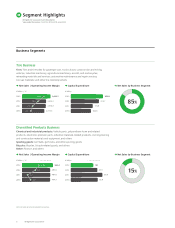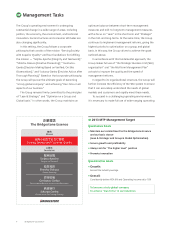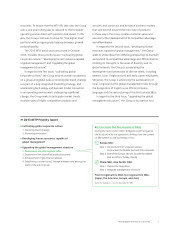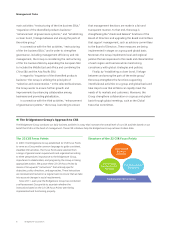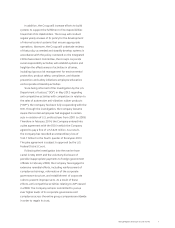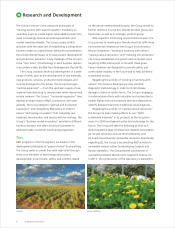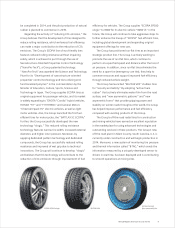Bridgestone 2013 Annual Report Download - page 13
Download and view the complete annual report
Please find page 13 of the 2013 Bridgestone annual report below. You can navigate through the pages in the report by either clicking on the pages listed below, or by using the keyword search tool below to find specific information within the annual report.
11Annual Report 2013 Operational Review
Continually enhancing corporate governance is one of
management’s most important focus points. This will
ensure that the Bridgestone Group continues to fulll its
founding mission as stated in its corporate philosophy:
“Serving Society with Superior Quality.”
Based on this approach, in accordance with the
responsibility and authority delineated in the Administrative
Authority Rules, as well as in the Policy Management Rules,
Bridgestone Corporation is committed to developing,
communicating, and abiding by fair, transparent decision-
making and management policies.
Overview of corporate governance system
Bridgestone has adopted a corporate ofcer system to more
clearly distinguish between management and operational
responsibilities. This system allows the Board of Directors
to focus more effectively on overseeing the execution of
business operations. There were eight directors, including
four outside directors, as of December 31, 2013. At the
Annual Shareholders’ Meeting held on March 25, 2014, all
of the directors reached the end of their tenure, and eight
directors, including four outside directors, were elected.
Bridgestone has adopted a board of corporate auditor
governance model as specied in the Companies Act.
The corporate auditors audit the execution of duties by
the directors, while the Board of Directors oversees the
execution of duties by the directors. As of December 31,
2013, the Board of Corporate Auditors had four members,
including three outside corporate auditors, one of whom
was a full-time outside corporate auditor. At the Annual
Shareholders’ Meeting held on March 25, 2014, one
corporate auditor reached the end of his term of ofce
and retired, and one corporate auditor was elected. As a
result, the Board of Corporate Auditors has four members,
including two outside corporate auditors.
In addition, to further increase the transparency and
impartiality of corporate governance, the Nominating
Committee, Compensation Committee, and Governance
Committee were established as advisory bodies to the
Board of Directors. Following deliberations, these
committees provide advice to the Board of Directors in
regard to such matters as personnel issues that involve
directors, the compensation of directors (when the total
amount of auditor compensation is revised, then that
amount), and the governance system and related issues.
As of March 25, 2014, Bridgestone established its
Compliance Committee and this committee is working to
achieve “the higher level” of a rigorous governance system.
These four committees are composed of four outside directors,
and one or more corporate auditors participate as observers.
In regard to personnel and compensation matters that
involve corporate ofcers who are not concurrently
serving as directors, the Ofcer Nomination and
Compensation Committee serves as an advisory body to
the CEO and Representative Board Member (CEO) and the
COO and Representative Board Member (COO), who
are the leaders of the operating divisions. Following
deliberations, this committee provides advice to the CEO
and COO, and then further deliberations are held at
meetings of the Board of Directors, which makes the
decisions. The Ofcer Nomination and Compensation
Committee is composed of ve or more members who are
selected from among directors, corporate ofcers, or
divisional heads who have been nominated in advance by
the Board of Directors. In addition, one or more corporate
auditors participate as observers.
Bridgestone has a management system in which the
CEO and COO are the leaders of the operating divisions.
The CEO is principally in charge of overall management
and strategy, and the COO is principally in charge of
operations. At the same time, these two ofcers implement
a system of mutual checks. In addition, the Chairman of
the Board leads meetings of the Board of Directors and the
Annual Shareholders’ Meeting. The Company has taken
steps to further strengthen its corporate governance
system by separating and clarifying the respective roles
and authority of the CEO, COO, and Chairman of the
Board, by advancing the sharing of information; and by
increasing the transparency of decision-making processes.
In the operating divisions, the Company has
established the Executive Operational Committee, which
deliberates and reports on specic matters set forth in
Company policy as well as other important matters. In
addition to key corporate ofcers, such as the CEO and
COO, the full-time corporate auditors are also standing
members of the Executive Operational Committee. In this
way, the committee ensures that information about the
status of management execution is shared and that the
supervisory function is fullled. As described above, the
Ofcer Nomination and Compensation Committee has
been established as an advisory body to the CEO and COO.
The committee provides advice on personnel and
Corporate Governance, Compliance, and Risk Management



